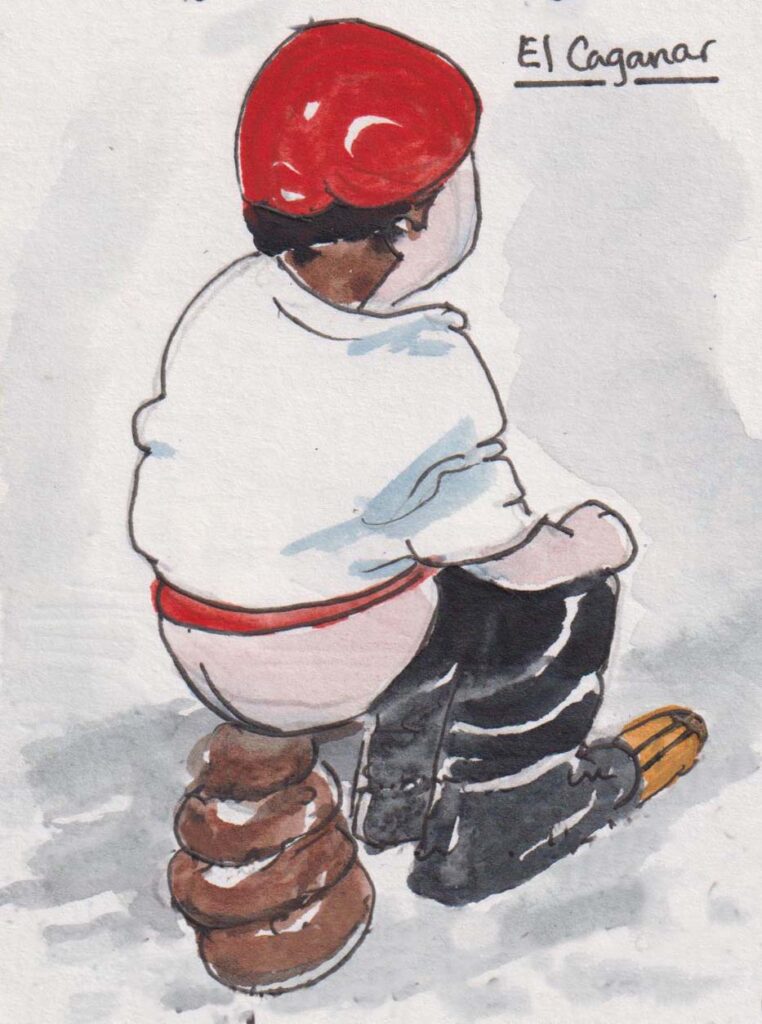Whenever we go on holiday, we keep a journal of where we have been and what we have seen, one of us doing the writing and the other the illustrations.
Our latest trip was to Barcelona for a week in September, staying with family just outside of the city itself, in Vallvidrera. We were privileged to be staying with our son and daughter-in-law who have written a number of travel guides and who already have a good knowledge of Barcelona. It was Violetta who acted as our guide.
As we were staying a little outside the city centre it was an important first step to get hold of a travel pass. Various passes are available and, because there are so many fascinating things to see and do in Barcelona, a travel card which allows you to hav unlimited journeys on trams, buses, suburban trains, the metro, and other transports seemed the best option.
 The Hola Barcelona Travel Card can be purchased for 2, 3, 4 or 5 days. We went for the T-usual Card which gave us unlimited travel for a month and cost only €20. (Pic 1).
The Hola Barcelona Travel Card can be purchased for 2, 3, 4 or 5 days. We went for the T-usual Card which gave us unlimited travel for a month and cost only €20. (Pic 1).
Before we went into Barcelona to experience just a fraction of what is there, we would take our grandson, Flavio, to school. This involved using a bus, the funicular railway and one stop on the S1 or S2 train, then a reverse journey.
Before we had even started to go into Barcelona, we had chalked up six journeys using our T-usual Card. During the week we must have made 60 journeys at least. Not bad for just €20!
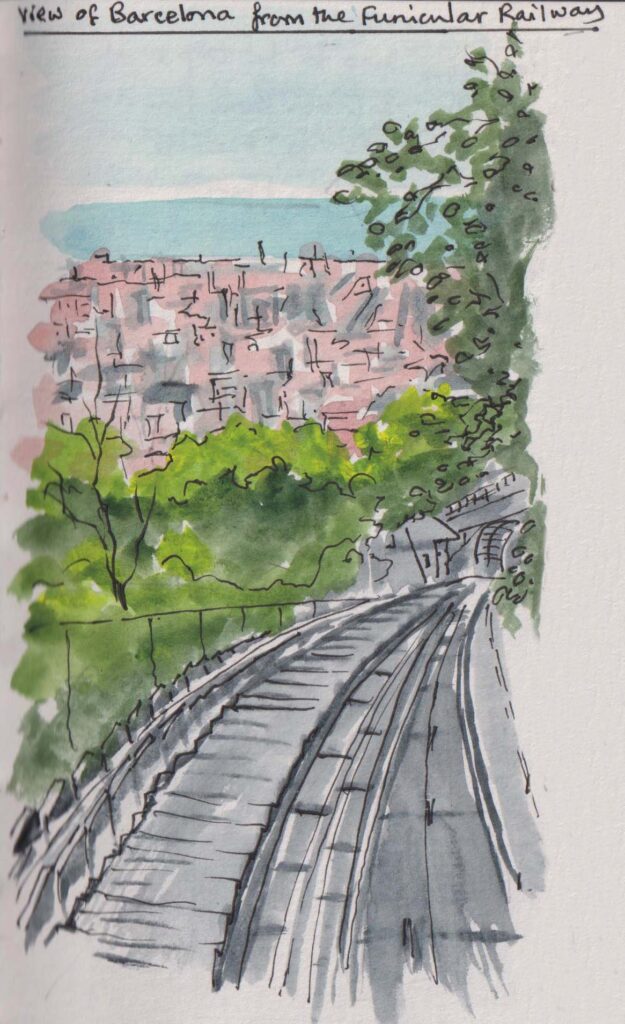
Taking Flavio to school also gave us a chance to stop off at a recommended café/bakery, ‘Vivari’, in the Sarrià district. A coffee and croissant there cost us just €2/per person – which was why I often had more than one helping! The café was also well-attended, both inside and with people taking away a very wide range of bakery items.
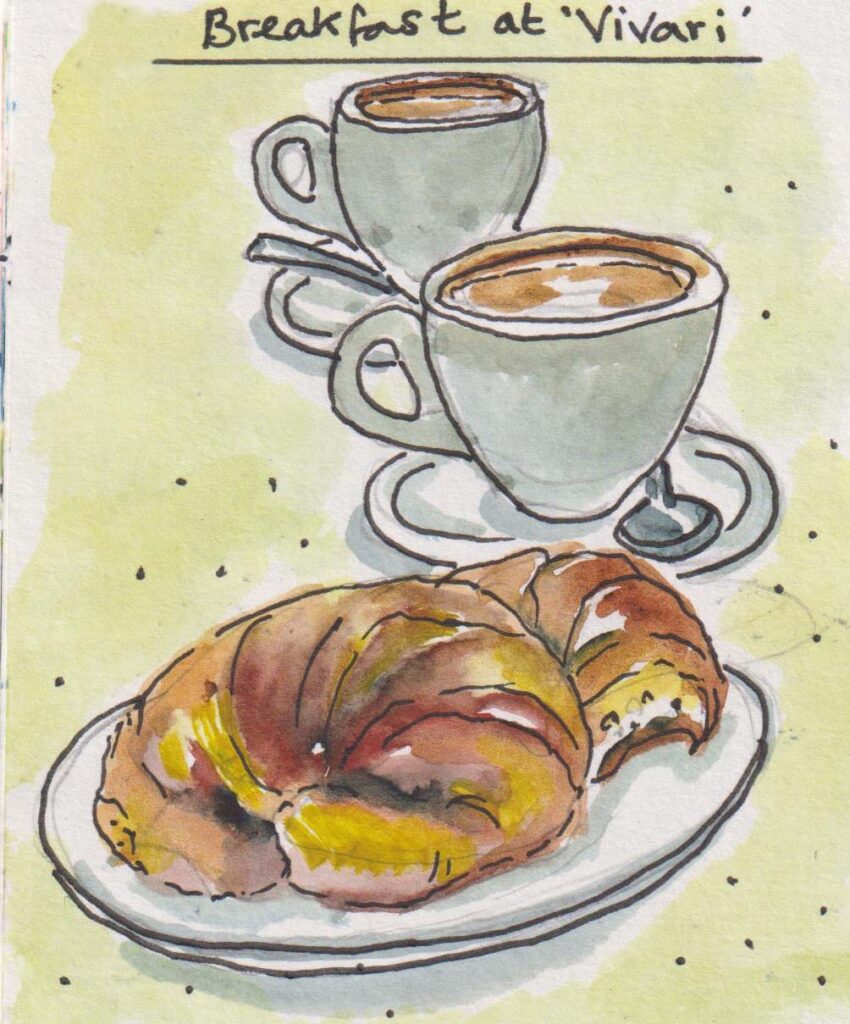
Thursday 21st Sept
Our first exploration of sites was Vallvidrera itself as we were staying there.
We walked up and over the steep hill to get there from where we were staying, hoping to find a coffee shop. Plaça de Vallvidrera has two coffee shops/restaurants which seem to alternate in terms of being open.
The one that was open had all of the outside seats occupied, and inside it was very hot and stuffy, so we went up to Plaça de Pep Ventura. Just at the top of the square there is a take-away café from which we purchased a very good-value omelette baguette, freshly cooked as we waited.
Returning home, Violetta took us on our first real experience, opening our eyes as to just how much there is to see everywhere one goes.
Taking the bus, we went up to Tibidabo where there is both the amusement park and the Temple Expiatori del Sagrat Cor de Jesús (Church of the Sacred Heart).
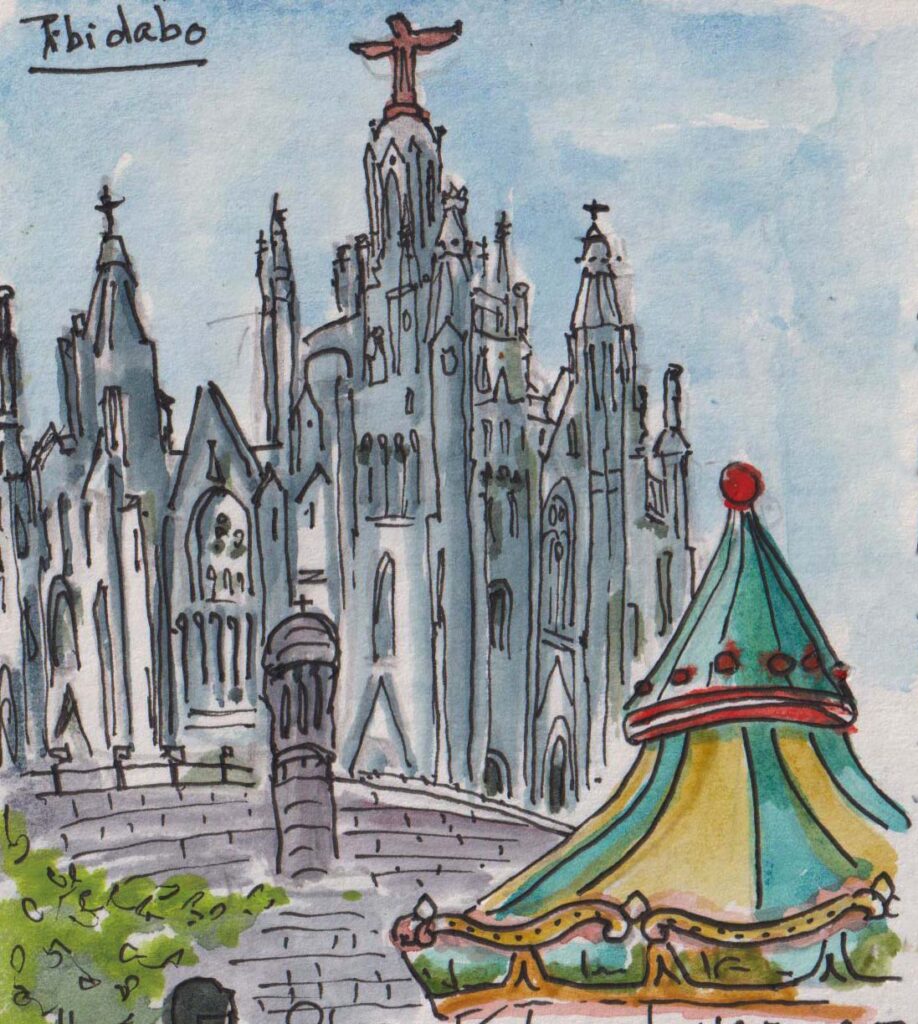
The church is located 512 metres above sea level and offers great views over Barcelona, as does the bus trip up to Tibidabo.
The main entrance to the church is through a baroque-style doorway beneath a mosaic arch that depicts Jesus surrounded by angels and Spanish saints. The top of the amusement park is free to enter and one can see some of the attractions. There are in fact many others, including a rather scary roller-coaster ride through the wood on the side of the hill. These are out of sight from the top.
On the way up to Tibidabo one can see the Observatori Fabra, also providing great views over the city. Two observatories were originally built on La Rambla in the centre of the city. However too much pollution made them difficult to use, so Observatori Fabra was built between 1894 and 1904. It is one of the oldest still-active observatories in the world. As well as providing scientific studies it is also possible to have ‘dinner with the stars’ in the summer months; booking is essential – and the place is not cheap!
Friday 22nd Sept
Having taken Flavio to school, and enjoyed Vivari coffee and croissants, we returned home for lunch before Violetta took us into Barcelona, this time to the end of the train line at Plaça de Catalunya.
From there we walked down La Rambla and then into the Gothic Quarter, passing Els Quatre Gats on the narrow Carrer de Montsió. The restaurant was the idea of Pere Romeu who copied it from the Le Chat Noir in Paris. ‘The Four Cats’ has a significantly different meaning for the Catalonians as it is also a phrase that means ‘only a few people’.
It became a place frequented by many prominent modernist figures including Picasso and Gaudi. Closed in 1903 it has been restored in 1989 to its original condition, with many paintings and prints on the walls.
A couple of streets away from Els Quatre Gats is Plaça d’Isidre Nonell, where Joan Fontcuberta has created a mosaic of tiles, each showing one of 6,000 photographs of people, places, moments and events that were sent to him by Barcelona residents within four days of him asking for them.
What he created with them is really very clever and painstaking. The tiles have been laid out on the wall at the side of the Plaça to show two people kissing and is titled ‘El Món Nei xen Casa Besada’ – ‘The World Begins with Every Kiss’.

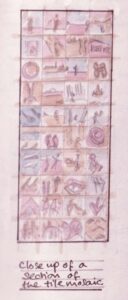 It was created as part of Barcelona’s tricentenary celebrations commemorating the fall of Barcelona during The War of Spanish Succession. Initially it is difficult to see what the tiles are showing but then the picture kind of comes into focus. It is inevitably a place where many people take selfies kissing their partners.
It was created as part of Barcelona’s tricentenary celebrations commemorating the fall of Barcelona during The War of Spanish Succession. Initially it is difficult to see what the tiles are showing but then the picture kind of comes into focus. It is inevitably a place where many people take selfies kissing their partners.
A very short walk took us to Plaça Nova where, on the front and sides of the promontory of the Col·Legi d’Arquitectes de Catalunya there is some of the street art commissioned from Pablo Picasso.
Here one finds the ‘Esgrafiat de dibuixos de Picasso de tema popular’, each side made with a technique known as ‘sgraffito‘. Originally the artwork would have been created by scratching through a surface with a stiletto to leave a pattern, although on this particular building it was done with sandblasting.
The original designs were made by Picasso on a napkin, then sent to Barcelona and actually reproduced by Carl Nesjar. The front image is the frieze of joy, with folk dancers and the palms and palmons of Palm Sunday. The other two friezes are: the frieze of the children and the frieze of the Senyera (the national flag of Catalan Estelada).

Across from Plaça Nova is Casa de L’Ardiaca (The Archdeacon’s House). Built in the 12th century using part of the Roman wall, it underwent a major renovation at the start of the 16th century under Archdeacon Lluίs Desplà with renaissance elements. We went up the steps into the elaborate entrance hallway, tiled and with an ornate fountain. Very relaxing in the afternoon heat. One noteworthy feature is the stone letterbox on the façade, the work of sculptor Alfons Juyol, showing five swifts, seven leaves and a turtle.

From the Archdeacon’s house we went across to the Cathedral, stopping on the way to listen to a group of school children singing. Some songs sounded like religious chants, others were very similar to the Medieval Babes.
As well as the impressive gothic architecture of the front of the Cathedral de la Santa Crue i Eulàlia (Holy Cross and Saint Eulàlia), there are the less ornate sides but with many gargoyles and sculptures. One of these sculptures is of Saint George (Sant Jordi) who is the patron saint of Catalonia.
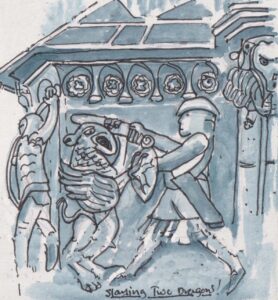 He was adopted as the patron saint in 1456, supposedly, in part, because it was in this region that he killed the dragon. The sculpture of him killing the dragon is facing outwards, but on the side of the pillar is another sculpture of someone else killing a dragon, Guifré el Pilos’ father.
He was adopted as the patron saint in 1456, supposedly, in part, because it was in this region that he killed the dragon. The sculpture of him killing the dragon is facing outwards, but on the side of the pillar is another sculpture of someone else killing a dragon, Guifré el Pilos’ father.
Unable to defeat the Barcelona counts the Saracens captured a young dragon in Northern Africa, then released it near Barcelona. As it grew it went from eating sheep and other animals, to young children, peasants and even knights. Guifré’s father attacked the dragon many times and eventually wounded it so gravely that it crashed into a mountain and died.
The Cathedral also has two other patron saints. Eulàlia was a 13th century virgin, martyred for protesting against the way Governor Dacian was persecuting the Christians. She refused to end her protests and was stripped, flagellated, beaten, tortured and eventually died from her wounds. In the Cathedral there is a well around which 13 geese are kept, symbolising Eulàlia’s age and the number of tortures she suffered. The other patron saint of the Cathedral is ‘La Mercé’ (Mare de Deó de la Mercé – Our Lady of Mercy).
Violetta also showed us where a door high up on the side of the Cathedral seemed to go nowhere. There used to be a bridge across to the next building which allowed the king to get into the Cathedral unseen and away from the hoi polloi.
A little south of the Cathedral, and on a slightly circuitous route back to La Rambla, we passed the El Caganer shop on the corner of Baixada de la Llibreteria and Carrer de les Trompetes de Jaume I.
A caganer is a figurine in the act of defecating, ‘El Caganer’ – ‘The Pooper’. It is a traditional Christmas decoration and symbolises fertilization of the earth, bringing health of body and peace of mind.
In Catalonia, the caganer is traditionally seen wearing a red Catalonian cap and a white peasant shirt. But now shops stock a huge range of different characters including well-know sportsmen, musicians and even politicians. This shop had Trump, the Queen and even the Pope.
We walked back to La Rambla which is probably the best-known street in Barcelona: 1.2 kilometres long and stretching from Plaça de Catalunya to the Monument a Colom (monument to Colombus) down by the port. Then up to the train and on to meet Flavio before a beer in a plaza near his school as he played with his friends.
Saturday 23rd Sept
We took the train into the centre and then the metro to Sant Pau, Dos de Maig.
While waiting for Violetta to join us, we walked with our son, Blake, up to Sant Pau Art Nouveau Site, an impressive building. Built at the start of the 20th century the site now comprises a total of 27 Art Nouveau buildings. It was actually a working hospital until 2009.
The Hospital de la Santa Creu was founded in 1401. Pau Gil Sarra died in 1896 and left 3,060,000 pesetas for the construction of a new hospital. Between 1902 and 1930 the new hospital was built, designed by architect Lluís Domènech i Montaner, but it subsequently fell into neglect. The major renovations turned it into the Art Nouveau site that it now is, once the hospital had closed.
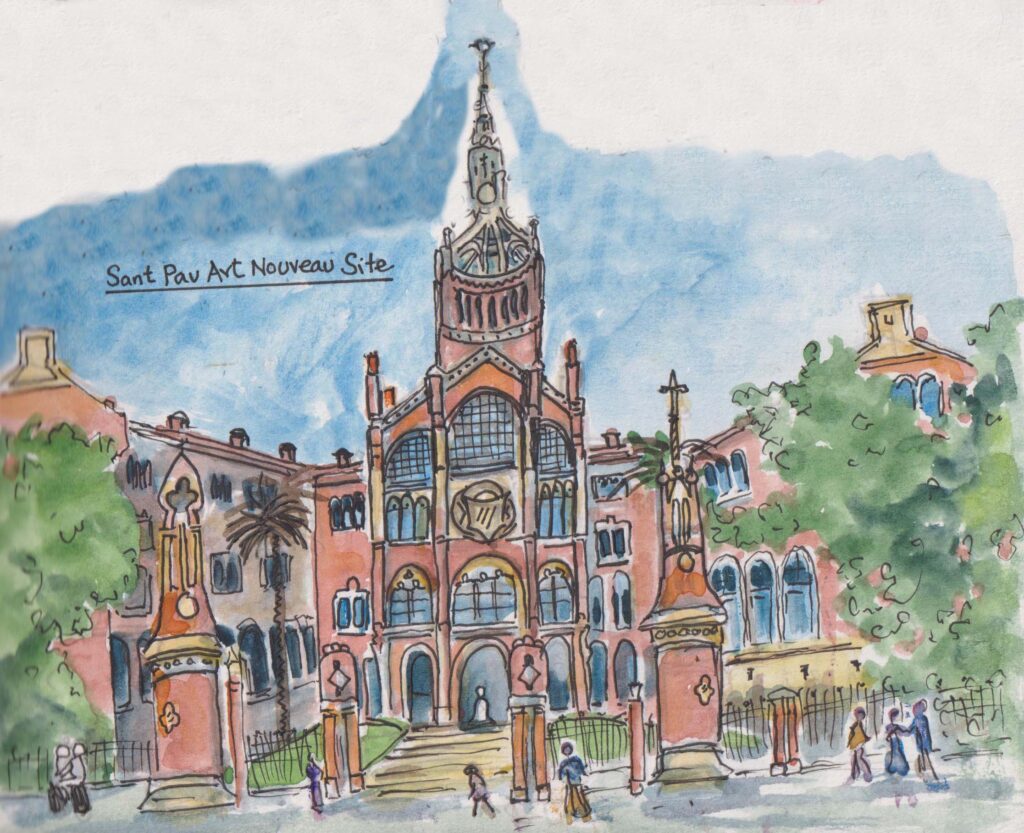
Once our party was at full strength, we walked down the Avinguda de Gaudi, which goes straight to the Sagrada Familia – now Gaudi’s most famous building.
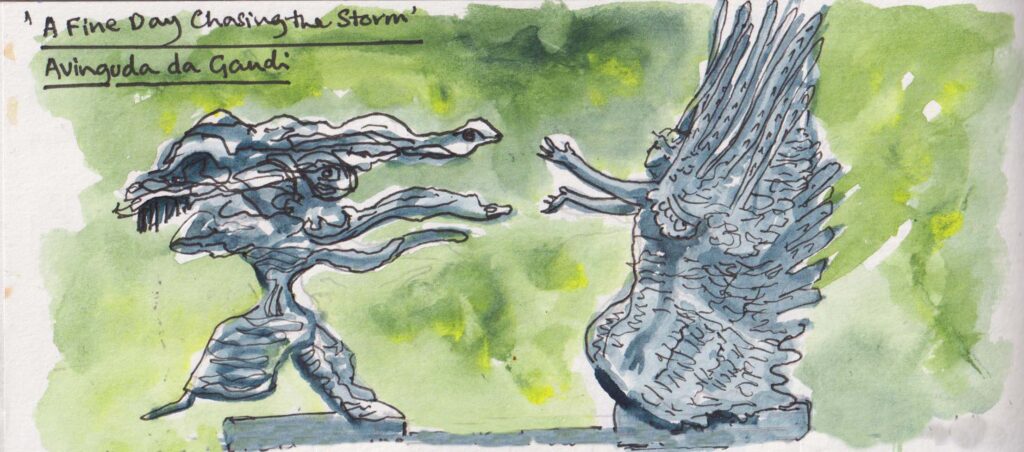
Barcelona must be the city in the world with the most sculptures, statues, unique buildings, decorations on buildings, ornaments of one kind or another that festoon the streets, plazas and parks. Avinguda de Gaudi is no exception. Within a few metres we came across the sculpture by Apelles Fenosa created in 1878, ‘El buen tiempo persiguiendo a la tempestad’ (A fine day chasing the storm).
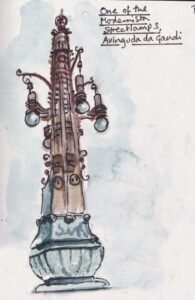 The Avinguda also has in 1909. They originally stood at the crossroads between the Passeig de Gràcia and the Avinguda de Diagonal but were removed from this site in 1957 because they were a hindrance to traffic. They were placed along the Avinguda de Gaudí in 1985, after being stored for many years in a local warehouse. Other Falqués lampposts are on the Passeig de Gràcia.
The Avinguda also has in 1909. They originally stood at the crossroads between the Passeig de Gràcia and the Avinguda de Diagonal but were removed from this site in 1957 because they were a hindrance to traffic. They were placed along the Avinguda de Gaudí in 1985, after being stored for many years in a local warehouse. Other Falqués lampposts are on the Passeig de Gràcia.
Down the Avinguda lies what many tourists clearly consider is the main attraction of Barcelona: the Basilica I Temple Expiatori de la Sagrada Familia, consecrated as a ‘minor basilica’ by Pope Benedict XVI in 2010.
This basilica was started by Francisco de Paula del Villar in 1882 but Antoni Gaudi took over the design in 1883 when Villar resigned. When Gaudi died in 1926, after being hit by a tram, less than a quarter of the Sagrada Familia had been built.
Slow progress since then was not helped by the Spanish Civil War and the FAI setting fire to the crypt, breaking into the workshop and destroying some of Gaudi’s plans. Even so, the planned completion keeps being extended – now to 2030 or 2032.
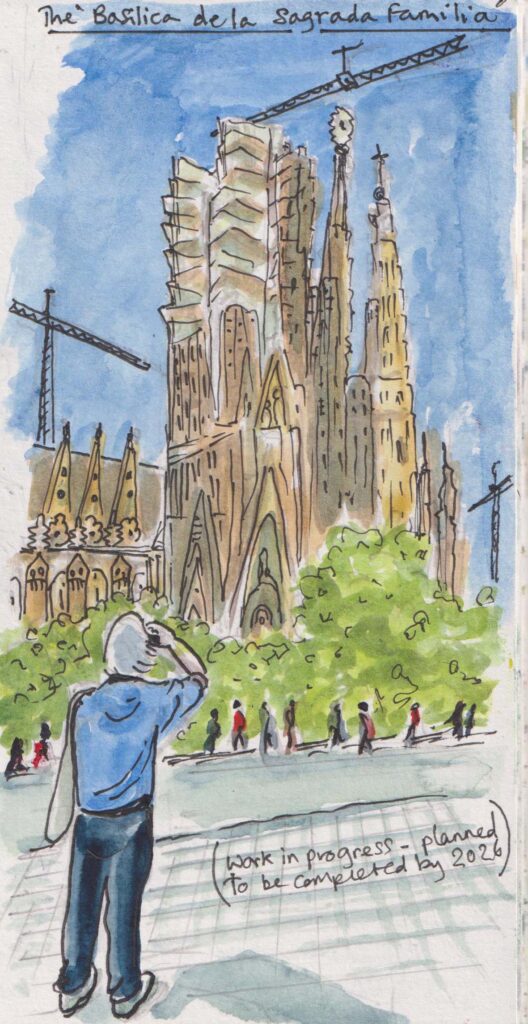
The structure is so complex and detailed that one needs days rather than hours to take it in. We started at the east entrance, which is the only facade finished while Gaudi was alive.
The façade depicts the birth of Christ, with three major portals: the portal of hope, portal of mercy and the portal of faith. There is so much detail that one can only really take in small parts of it, such as on the Nativity façade where Mary and Joseph are by the crib and arched around them are figures playing musical instruments, including a harp.
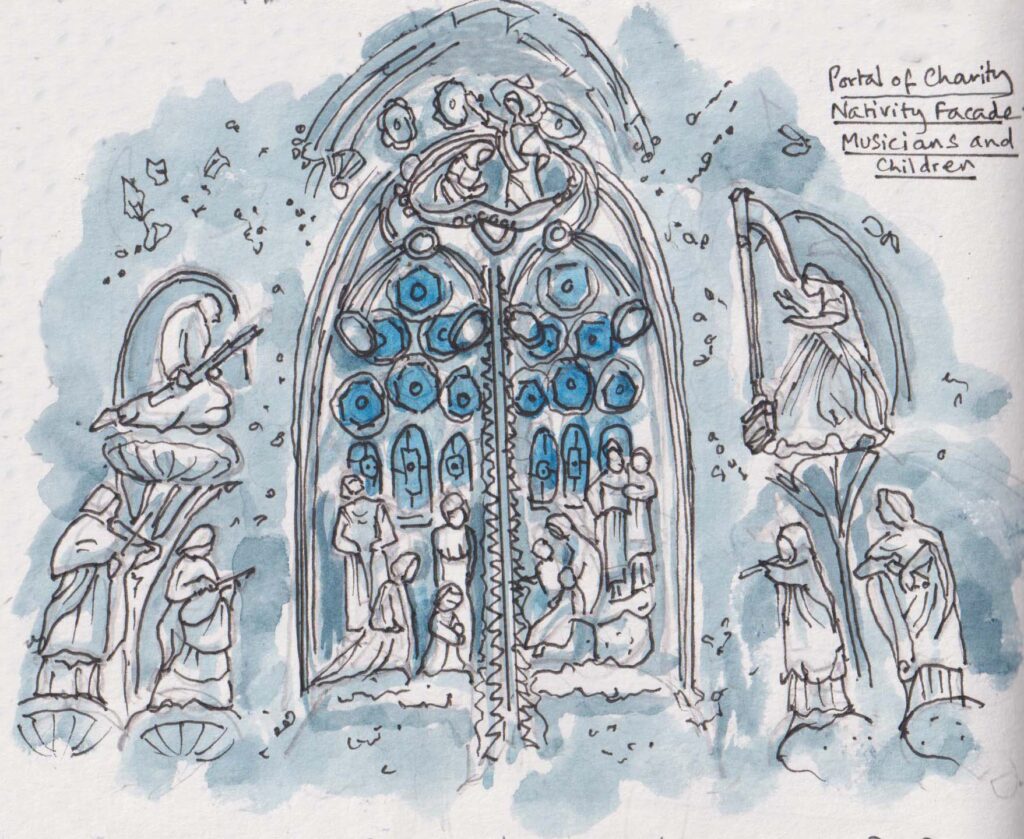
We then went round to the Passion Façade, again filled with a myriad of sculptures, and finally completed in 2018. Gaudi wanted this façade to depict misery and death, including the brutality of Jesus’ execution. Central features are the carrying of the cross and the crucifixion.
And finally, we went to the Glory Façade, which is still under construction and will be the tallest part of the basilica. The Glory Façade will form the main entrance to Sagrada Familia when it is completed, but there is a major obstacle to this.
Dedicated to the resurrection and ascension of Jesus Christ, the Glory Façade comes in direct conflict with hundreds of homeowners living on the other side of narrow Mallorca Street. The planned staircase that would serve as the main entrance to the basilica could mean demolishing several buildings on the other side of Mallorca Street, leading to thousands being evicted and forced to move elsewhere. The residents dispute the assertion that their properties were only under temporary residency contracts and say that the planned staircase was never on Gaudi’s original plans. A major court case is underway.
On the way back to the station we stopped at one of Barcelona’s many tapas bars, serving very good home-made vermouth (Violetta’s recommendation!) We also had patatas bravas and croquettes.
Sunday 24th Sept
The day started with a visit to a restaurant, El Raco de Collserola, in Baixador de Vallvidrera, which Blake insisted did very good breakfasts. Sited at the Parc de Santa Maria de Vallvidrera, the restaurant is very popular with walkers, cyclists and locals.
We had outdoor seating and it was already fairly crowded. We were persuaded to try the local sausage in a baguette, with a touch of tomato flavouring on the baguette and peppers and tomatoes. Very good, but also very filling.
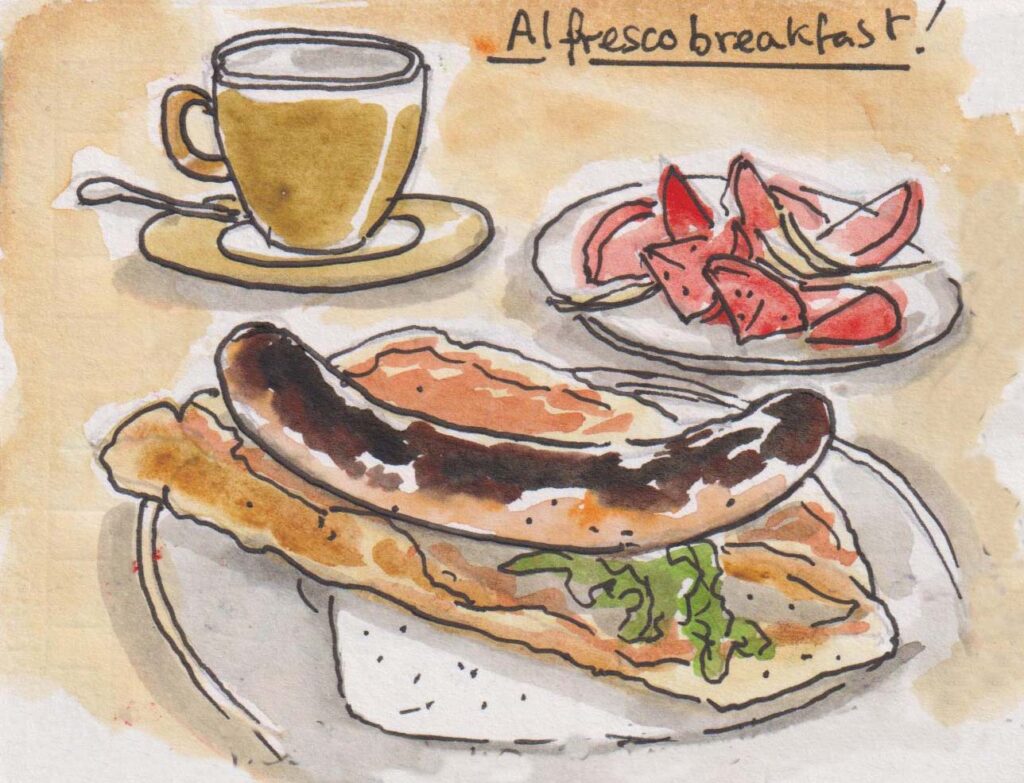
We left the car near the restaurant and took the train in to Barcelona to see some of the Mercè Festival. This is held every September for four days. The festival includes many events, parades, music, a fire run and, on the day that we went to see it, a parade of giants and human towers! The festival is held in honour of Mare de Déu de la Mercè, the patron saint, and bids a farewell to summer, welcoming the cooler months of autumn.
From Plaça de Catalunya we went down La Rambla to Calle de Ferran.
On the Rambla there were suddenly many police motorcycles and then ambulances. A lady had been hit by a bus as she crossed the street without looking. With the huge number of people that are often on La Rambla, and other streets, this is a very real danger.
As we walked up Calle de Ferran the street was already crowded with people getting the best places from which to watch the parade of giants.
The parade and dancing of the giants started in Plaça de Sant Jaume and by the time we got there it was packed so full that it was difficult to find a place where we could see what was going, a particular problem for our grandson.
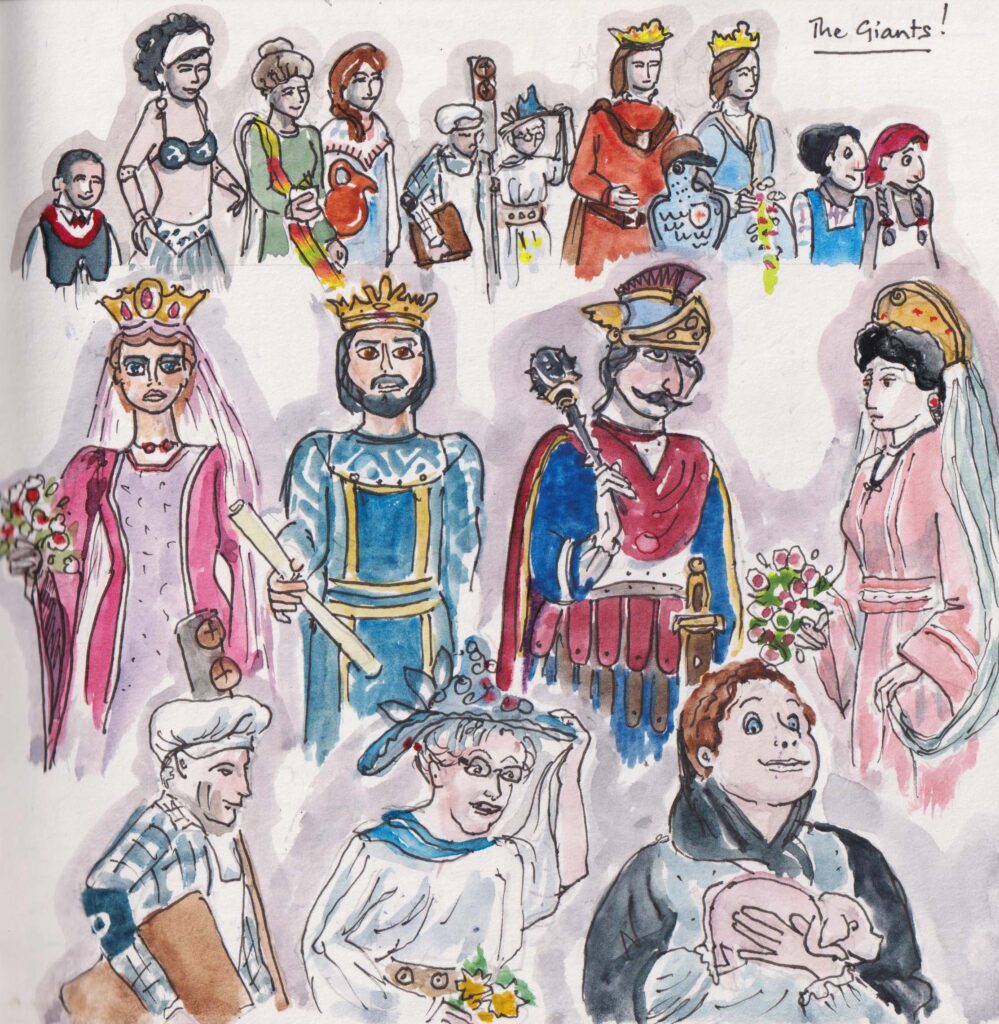
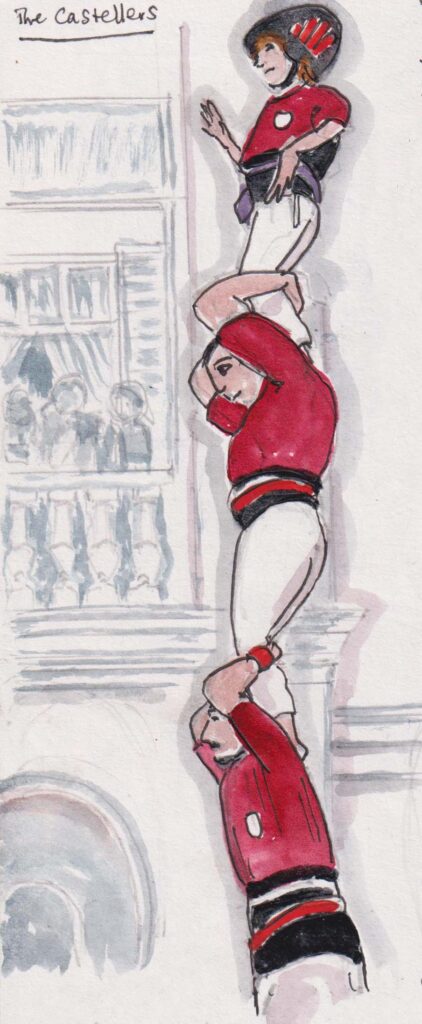 The giants were displayed all around the Plaça and took turns to dance in front of Palau de la Generalitat, an historic palace that now houses the Presidency of the Generalitat de Catalunya.
The giants were displayed all around the Plaça and took turns to dance in front of Palau de la Generalitat, an historic palace that now houses the Presidency of the Generalitat de Catalunya.
Some dignitaries appeared on the balcony, one looking remarkably like Pere Aragonès, the current President of Catalunya.
This year Ukraine was invited to take part and presented two giants, Olga and Volodymyr, who represent their princely saints.
As the giants started their parade, they all passed just in front of us and we could see just how heavy they were, each held by one man lifting up the heavy wooden frame. They needed to periodically replace the person doing the carrying, who also had to move the giant in a dance.
After all the giants had gone down Calle de Ferran the acrobats for the human castles, the Castellers, came in and the crowd was pushed back even further with no space for us to go.
We watched the first part where a human castle of three was held up by five or six below, the top person being a child.
The person at the top now wears a helmet because a 12-year-old girl, without a helmet, was killed falling from a nine-storey tower in Mataró in 2006. The smaller towers were constructed with no incidents, but when one of the larger towers was being built it did collapse. Luckily only bruises!
Monday 25th September
Today was a bank holiday and we decided we would go for a walk in the Pantà de Vallvidrera. We started from Vallvidrera itself and followed the well laid-out paths down to Baixador de Vallvidrera. Even here, in the middle of the woods there are statues, like the one of the monk offering a blessing, or a promise of comfort.
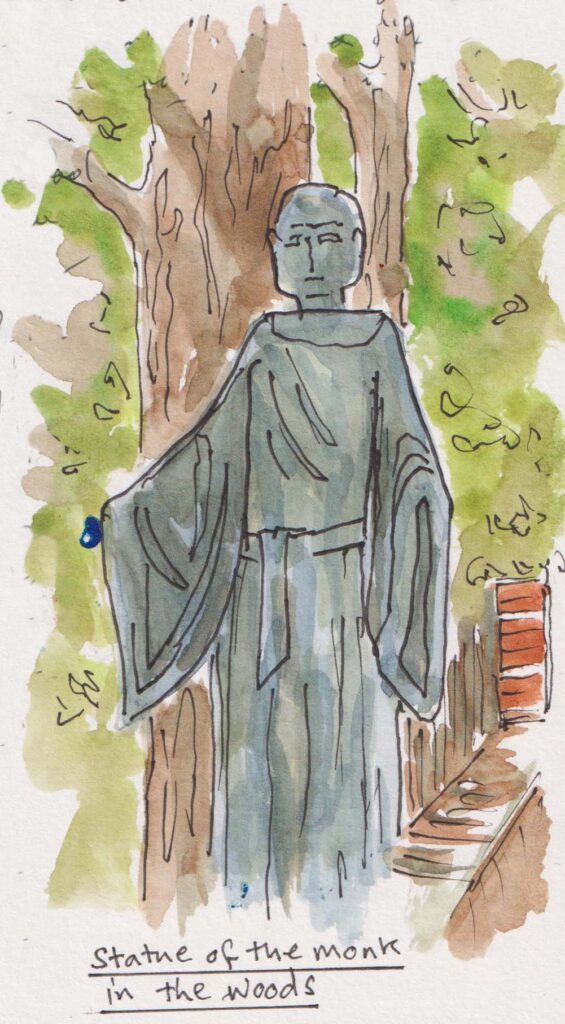
It was a hot day so we were happy to stop in Baixador for a beer at the other restaurant there, El N9U. Refreshed we headed back, one of us taking the obvious path and the other what looked like an obvious more direct route. Don’t need to guess who got back first.
With more family coming round for supper we did not go down into Barcelona.
Tuesday 26th September
After a rather rushed breakfast we took Flavio to school, had coffee and croissants at Vivari and then headed out without our guide, Violetta, to try to discover interesting parts of Barcelona on our own. That is not difficult to do when there is so much stunning stuff to see.
We decided to go first to one of the districts that the train passes through before going on to the centre. We stopped at Gràcia and wandered around for a bit, but not really doing it justice. We did go to the covered market where there were many stalls mainly selling, fruit and vegetables, meats, fish, cheeses or bakery items. It was well-used by the local residents but the prices were not particularly cheap.
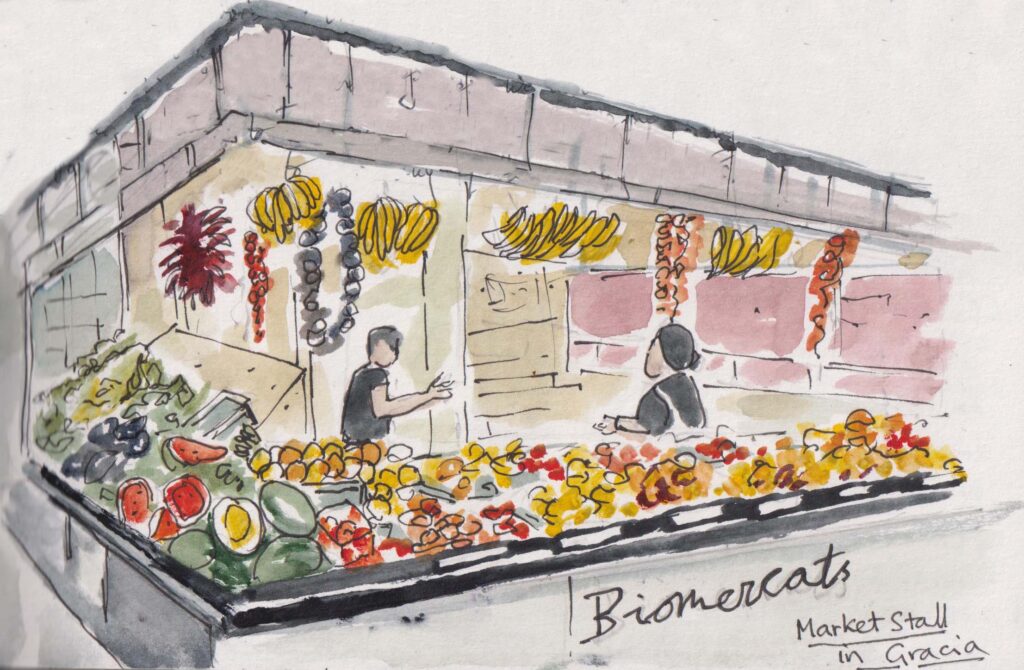
Getting ready to leave Gràcia station we came across one of the potential problems with the T-usual travel card. Because this has no limit to the number of journeys you take it does mean you cannot go through the same entrance or exit place within a certain time, probably 10 to 15 minutes.
Having put the card in the wrong slot I could not then get entrance and had to find someone to allow me in, at which point they asked to see my passport as its number had been used to buy the card and was printed on it. After some time explaining why I did not carry my passport around with me I was finally let in. I fully understand why this is done because otherwise one could simply pass the card over the barrier for someone else to use.
From Plaça de Catalunya we headed northeast to somewhere we had not visited before. One of the first places we found was the remains of the Covent de Sant Agusti.
It was here, in part, that the Baró Istardipé (The Great Gypsy Round-up) took place in 1749. On the night of July 30, King Ferdinand VI ordered the arrest and imprisonment of the entire Romani population and the confiscation of their lands and property. Between 7,000 and 12,000 were imprisoned. The men did slave labour in the arsenals or mines, women and girls were forced into convents or houses of mercy, children under the age of four were interned in religious institutions.
It is clear there is still anti-gypsy feeling here and conferences are held regularly to try to foster resistance to these feelings, the latest being on the 30th July 2023. Within the convent there is a courtyard where there is a very peaceful feeling and there is also a café in a
remaining part of the building.
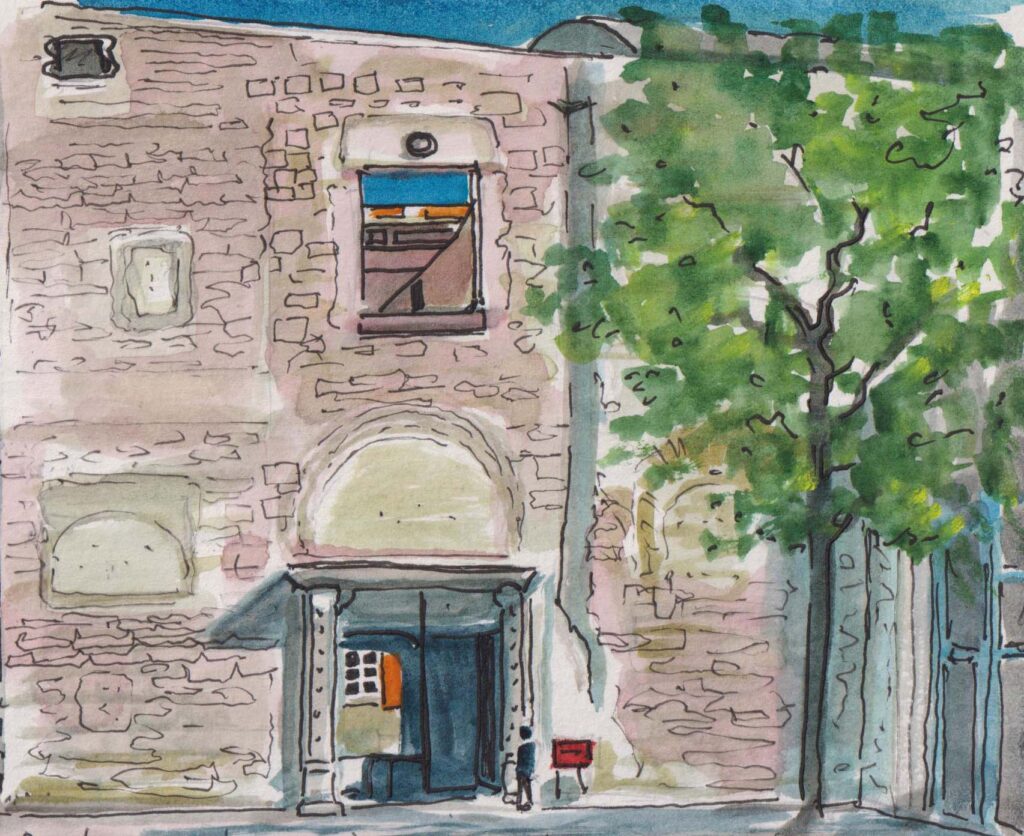
A short distance from the convent is the pedestrianised Passeig de Lluís Companys.
At one end is the Arc de Triomf and at the other the Parc de la Ciutadella. The Arc was built in 1888 as the gateway to the Barcelona World Fair held in the Parc itself. The architect was Josep Vilaseca I Casanovas. The two pillars of the arch have bats carved into the stone, bats being the emblem of King Jaume I.
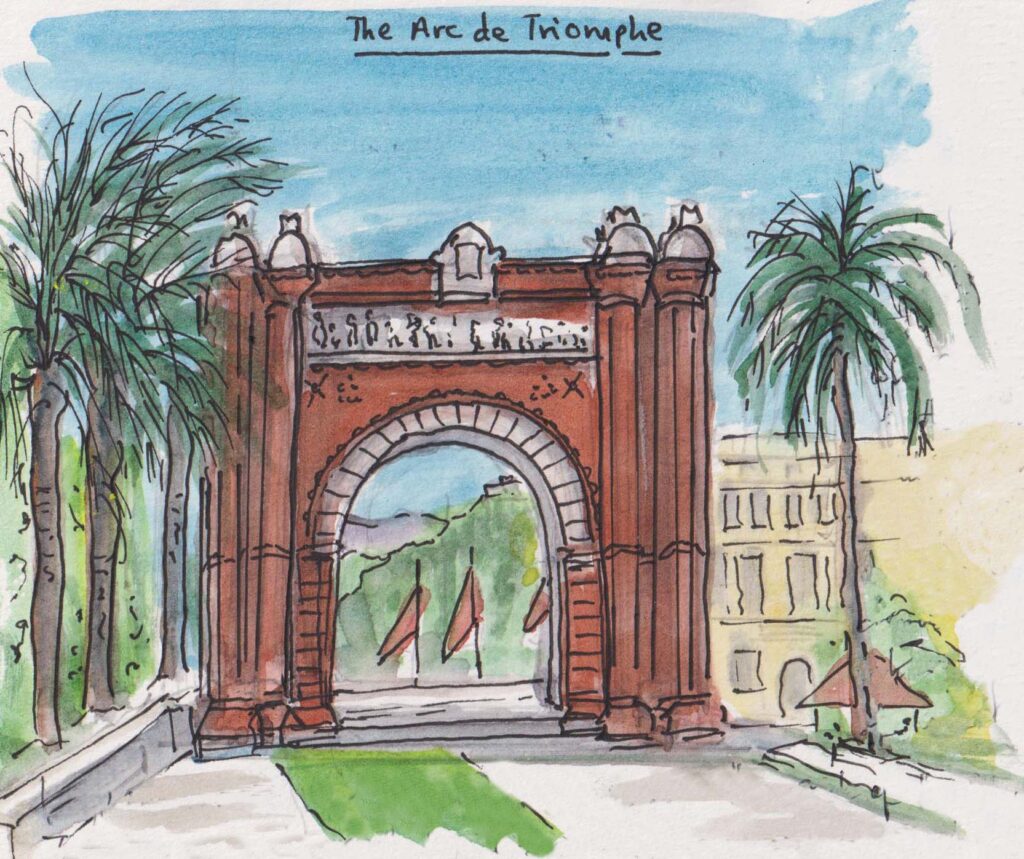
Lluís Companys, whom the street is named after, was head of the Catalan government during the Spanish Civil War and remained loyal to the Republican faction. Exiled to France after the civil war, he was captured by Germany’s secret police, handed over to Franco’s regime and executed by them in 1940.
On the side of the Passeig, like in so many streets in Barcelona, there are huge ornate streetlamps and at the end the monument to Francesc de Paula Rius with his bust and flanked by statues of a worker and a crowned female symbolising art and on the other side a winged figure with a torch symbolising fame and a naked child with book, globe and battery symbolising science. It’s all there and also then reflected in the Parc itself.
The citadel of the Parc de la Ciutadella was built by Philip V of Spain to control the Catalans. It was once the largest fortress in Europe. Today the Parc has many attractions including a zoo, the Catalan Parliament, the Museu d’Art Modern, the Castell dels Tres Dragons (containing zoology and geology collection), Hivernacle (winter garden), Umbracle (tropical greenhouse and shade loving plants) and a great many different statues and sculptures. We only walked round part of the Parc which included going to sit next to the boating lake.
Two of the sculptures we looked at were The Lion Hunter and The Stork and the Fox. ‘El Caçador de Lleons’ was placed in the Parc on the 21 st September 1883. White marble on limestone it was sculptured by Agapit Vallmitjana I Abarca. It is also described as an African
who seizes the cubs of a lioness fearful of being surprised by the mother.
The other sculpture is the ‘Font de la Cigonya i la Guineu’ by Edward Bastiste Alentorn, and depicts part of the Aesop fable of the stork and the fox where, as a joke, the fox serves up soup in a shallow dish and the stork cannot eat it with his long beak. In revenge the stork
invites the fox to dinner and serves up a fish dinner with a very appetising smell, but in tall jars that only he can get his beak into, so the fox goes hungry. Moral – Do not play tricks on your neighbours unless you can stand the same treatment yourself.
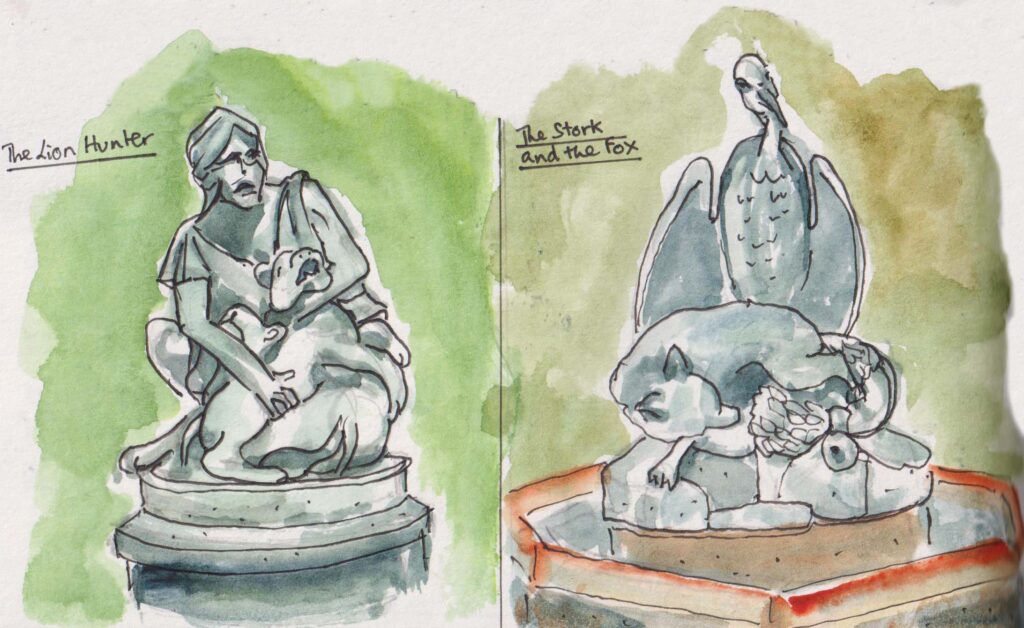
We walked back to Plaça de Catalunya in a rather round-about way, first to the edge of the port and then to Columbus’ statue before going all the way up La Rambla, walking very rapidly so that we would be in time to pick up Flavio. We should have used the metro!
Wednesday 27th September
 We took the train in as far as Proveça so that we could walk across, with Violetta as guide, to the start of Passeig de Gràcia. As well as the famous buildings by renowned architects there are also more streetlights designed by Pere Falqués i Urpí, in this case 32 in total, built in 1906.
We took the train in as far as Proveça so that we could walk across, with Violetta as guide, to the start of Passeig de Gràcia. As well as the famous buildings by renowned architects there are also more streetlights designed by Pere Falqués i Urpí, in this case 32 in total, built in 1906.
Each of the lampposts has a bench structure at the base with small ceramic pieces which glisten in the sunshine. On the street side there are metal doors into which hot coals would have been placed to keep the seats warm in winter as people waited for the trams.

Passeig de Gràcia is home to a mixture of upmarket stores and boutiques and what were the residential homes of rich traders, designed by the famous architects of the time who often competed to show that their building designs were better, or possibly more outrageous, than those of their fellow architects, and perhaps the most daring was Gaudi.
The first of Gaudi’s that we looked at was Casa Milà (La Pedrera – the Stone Quarry), commissioned by Pere Milà and his wife Roser Segimon (the wealthy widow of Joseph Guardiola, who had made his fortune with a coffee plantation in Guadeloupe).
The building was unique with the façade not being structural but acting almost as a curtain, blocks of stone fastened to the structure by metal components. The wrought-iron grills round the 32 balconies, in the shape of plants, leaves and animals, were all created from scrap-iron sheets, bars and chains. On the roof, which we could not see much of, are ornate ventilation shafts and chimneys.

Further down the Passeig there are five ornately designed residential buildings.
The first we came to was another Gaudi building, Casa Batlló. This has been nicknamed the ‘House of Bones’. This building was originally built in 1877 by Emilio Sala Cortés with a very ordinary façade. It was purchased by Josep Batlló y Casanovas, a textile industrialist, in 1903 and it being next to the ornate Casa Amatller, (who made his fortune out of chocolate), Batlló decided to give Gaudi a free hand in designing a new building.
Initially the original building was going to be knocked down but instead Gaudi decide to completely redesign the façade and create a totally new top. Gaudi’s façade has three distinct sections and, on the roof, what looks like the back of a dragon. What resembles a cross raised in the air could be the hilt of a sword that is being thrust into the dragon by St George.
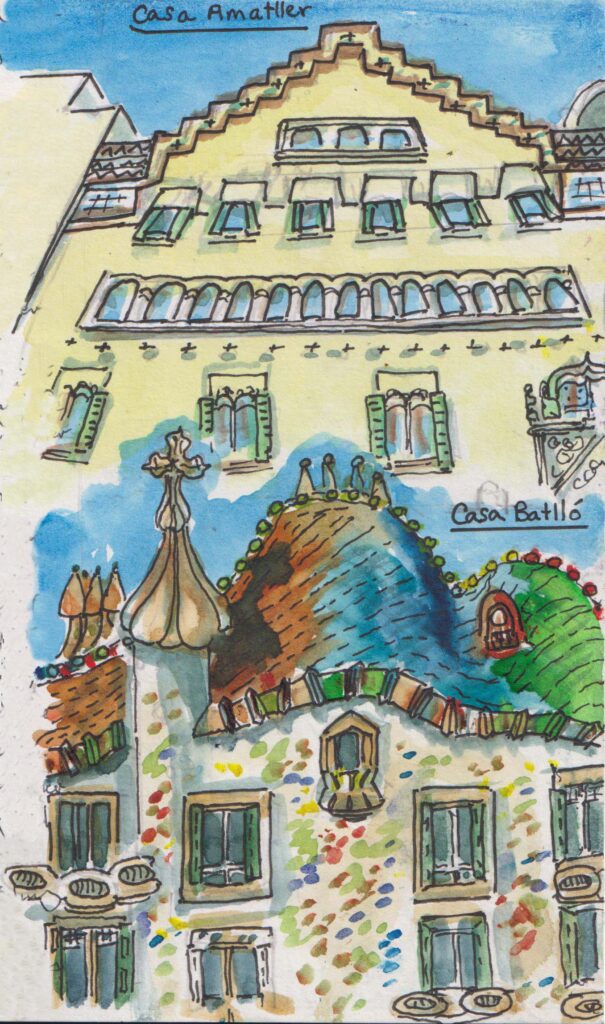
The competition between designers is obvious when one looks at the four buildings next to Casa Batlló.
First is Casa Amatller (by the architect Josep Puig i Cadafalch) inspired by Netherlands architecture. The second is Casa Josefina Bonet (designer Marcel-li Coquillat in an eclectic neo-baroque style). The third is Casa Mulleras (another textile industrialist) and was designed by Enric Sagnier. This is the only one of the five building that met official regulations and did not incur a fine. And, at the end, on the corner, is Casa Lleó Morera (by Lluís Domènech i Montaner), here with a hint of mulberry trees.
While looking at Casa Batlló and taking pictures someone had moved behind us and was quietly unzipping Violetta’s rucksack. Luckily, we noticed the person behind us acting strangely and nothing was taken.
Pickpockets are very common in Barcelona so one needs to be alert. The reason for this is partly due to Spanish Law. Non-violent theft of money or items worth less than €400 is not a crime, so very few people are prosecuted. Theft above €400 value can result in up to 6 months prison sentence. If there is violence during a robbery, the perpetrator can face between one and three years in gaol – so if a pickpockets are confronted they tend to run away, not wanting to be involved in any violence.
On our way to meet up with the rest of the family we went to a complex (El Nacional) where there were half a dozen bars/cafés under one roof all trying to outdo each other in their elaborate designs. The toilets were also elaborate, having been converted from what was once a garage and repair site. On the way out there was a line of mirrors that one might have found in a posh upmarket theatre.
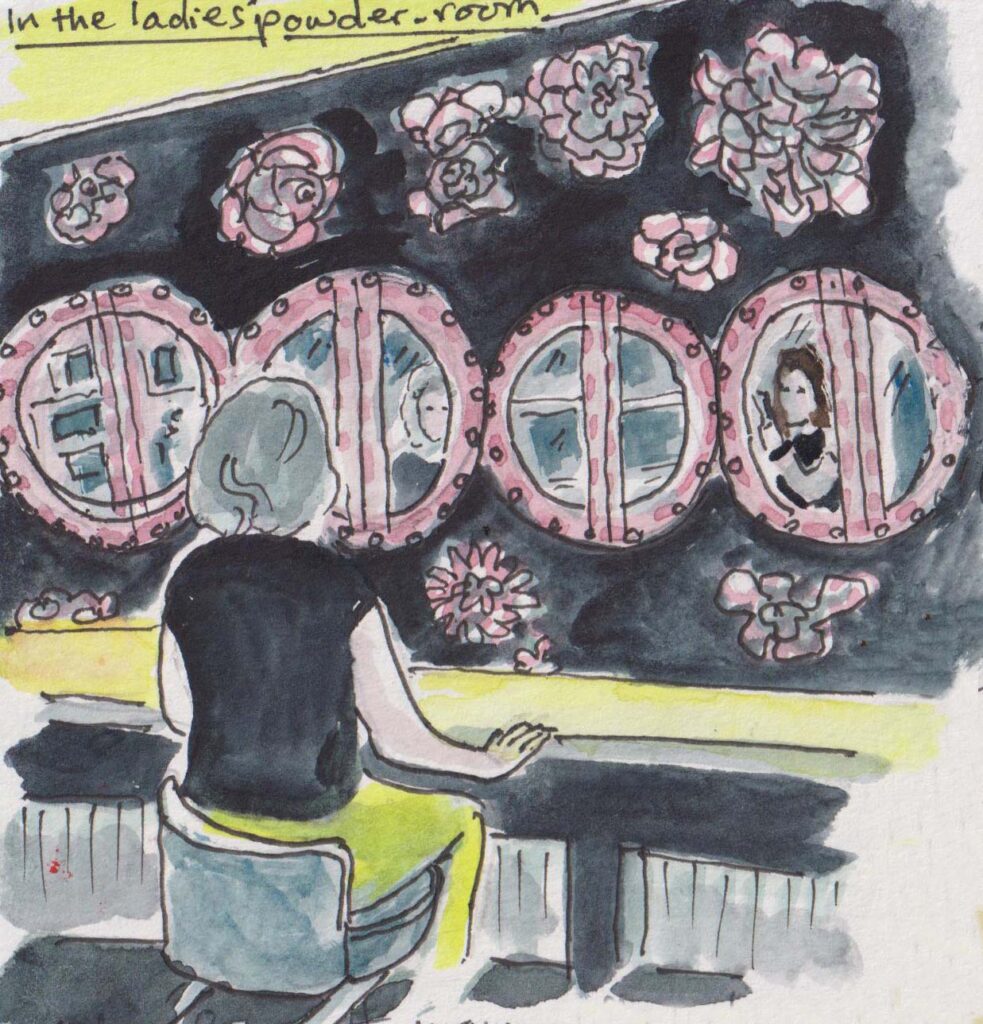
Walking on we came across a sign on Carrer del Pi for a shop selling nothing but Rubik’s cubes. This was in the Galerias Maldà where there were many shops dedicated to specific types of product including a Harry Potter shop (best selling wands being Harry Potter’s and, strangely, Voldemort’s), a boardgame store, miniature dolls shop, a costume shop (currently Halloween) and a sweet shop with Willy Wonka candies and chocolates.

Now having met up with Blake and Flavio we had beers and smack plates of meat balls and other dishes before we went on to The Comedy Clubhouse on Carrer del Canvis Nous (a street where money changers used to do business).
The Comedy Clubhouse also does ‘improv’ nights, when anyone who wishes to can join in. Improv is short for improvisation, a spontaneous ensemble theatre where the performers make up the theatre on the spot. Here it was done with scenarios given by the organisers.
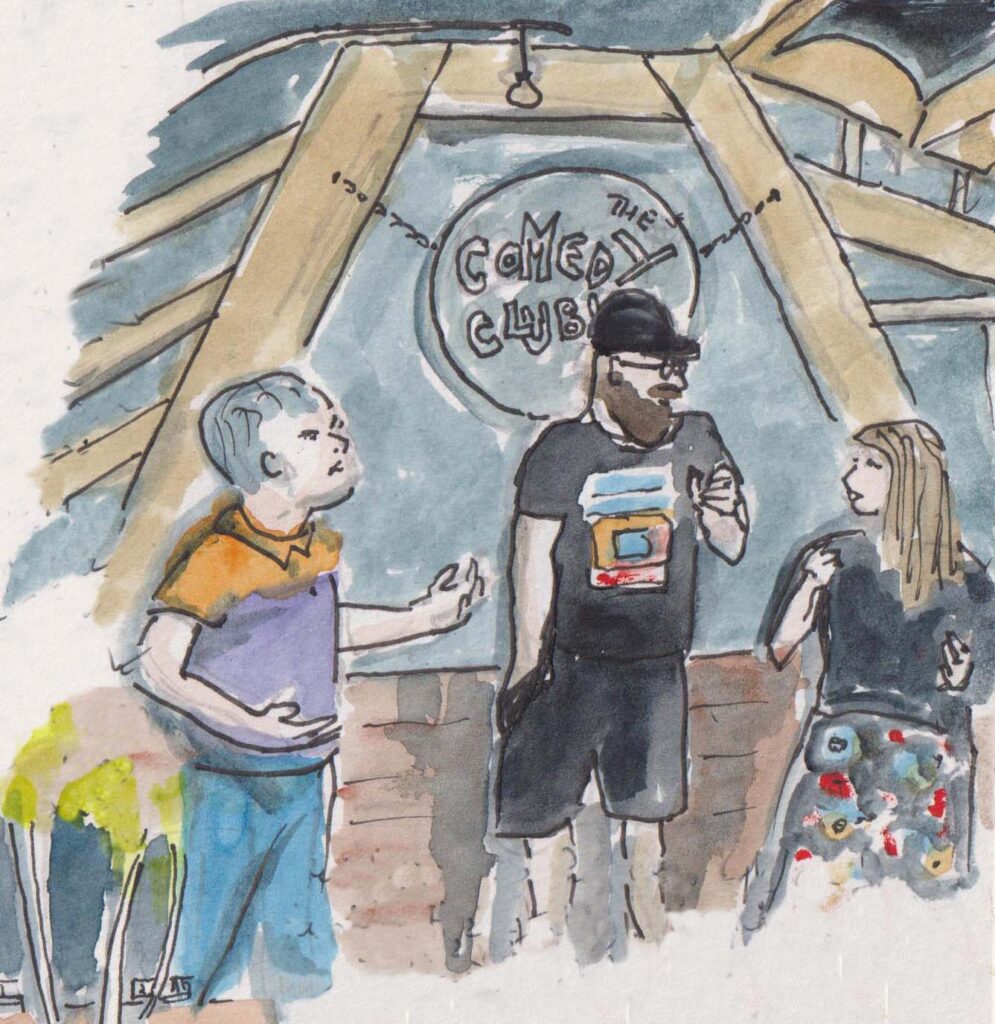
Home fairly late, trains and funicular still running, but no bus in Vallvidrera so we had to walk from the top of the funicular home. Next day was mainly packing and getting ready for an early start back to the UK after a very enjoyable week+ in Barcelona.
We will return.

